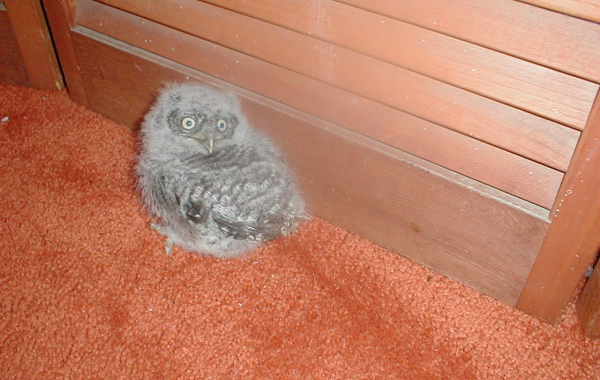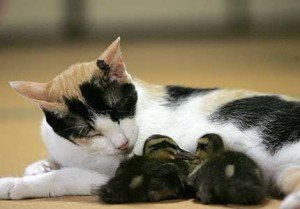
Why does this little Screech Owl look so horrified?
It’s not because of the color of the carpet, although I was probably wearing the same expression when I first saw it. It’s because she’s in a house, she’s scared to death, and she wants her mother. If that’s not possible, she needs the knowledgeable care of a licensed wildlife rehabilitator.
Wildlife rehabbers love the public. Except when we don’t love the public.
We love the public because there are good Samaritans who will find an injured or orphaned wild creature and go out of their way – sometimes way, way out of their way – to help. They may have no idea what they’re doing, but their compassion overrides their doubt. Somehow they manage to get the bird or animal to a rehabilitator, even though finding one is often a feat in itself. And sometimes they even give us money, which elevates them to sainthood.
To these people, we owe our gratitude.
Why do wildlife rehabilitators not love the public?
For one – and we’ll stick with this one issue for now – because sometimes the public decides to keep the animal they have found, just for a little while.
This is always, always a bad idea.
The state of Indiana has been soliciting comments for a bill which would make the above scenario legal for 90 days, creating an uproar among those who are licensed to care for injured and orphaned wildlife. Today is the final commentary day. With luck, there has been enough negative feedback to stop this kind of insanity in its tracks, although it bears monitoring because there are no guarantees.
Even with the Internet up and running, rehabbers still receive nestling songbirds who have been fed milk with eyedroppers – at least, we receive the ones who haven’t immediately drowned. We receive nestling owls who have been fed nothing but hamburger, whose bones are so brittle from lack of calcium that they break when they try to stand.
In a perfect world, people would know better. They would realize that wild owls fly silently through the night and grab unwary rodents, not unsuspecting packages of processed cow meat. And they would realize that any species whose young tried to nurse with a pointed beak would be a short-lived species. But it’s not a perfect world and sometimes people fail to think things through, which is why unlicensed individuals shouldn’t be allowed to keep a wild animal for 90 minutes, let alone 90 days.
A pet cat raising orphaned ducklings! How cute! That is, until the ducklings grow up, are released into a pond, and greet the local feral cat colony as long-lost relatives. An orphaned fawn who is best friends with the family’s German Shepherd! How cute! That is, until … you get the picture.
So: what do you do if your six-year-old finds a baby bunny, and she can’t bear to part with him?
Explanations are simple: only a mother rabbit or a highly trained rehabilitator has a chance of raising and releasing a healthy wild bunny. And like humans, if a wild animal is injured he needs to be treated by a licensed medical person, not a well-intentioned accountant, plumber, or six year old child.
Instead, bring your child to fundraisers, to sanctuaries, to demonstrations with trained education animals. Teach her to do the right thing, even if it makes her a little sad, because help without knowledge is no help at all.
“Trust me,” says Kathy Uhler, co-founder of the Pocono Wildlife Rehabilitation and Education Center in Stroudsburg, PA. “I know nothing about kids. If I found a child wandering around the mall and tried to take him home and care for him, I’d release him in much worse shape than I found him.”
To those compassionate, caring individuals out there who find themselves with injured or orphaned wildlife: if you love them, let them go – into the waiting hands of a licensed wildlife rehabber.















“help without knowledge is no help at all.” what a GREAT line. hope you don’t mind if I borrow that one, suzie. excellent article. it is both funny, and not funny at all.
Borrow away, Erin! And I’ll borrow yours – your last line pretty much sums it all up.
Lmao! I was just helping my daughter find a rehaber for an injured Robin (shes 21 not 6!) LoL anyways..you’re right on several counts including you guys being very hard to find! Everyone keeps sending us to someone else and all those someone elses are closed at 4 pm..its almost 7. I currently have a robin in my bath tub (no water) because I also have 12 cats indoors as well as care for a feral colony of 40 cats close by. Putting this poor bird outside is as good as ringing the dinner bell…if thats not what happend to begin with, which I kind of doubt considering most times if I find anything at all besides feathers…its only beaks and legs 🙁 the meer fact that this bird is breathing suggests a cat was not involved but I could be wrong. Anyway..your posts are hilarious! Thanks for your insight!
Educating the public is the key. First, they need to know that there is such a thing as a licensed wildlife rehabilitator, then they need to be able to find one when they need one. It would be great if each state would keep a list of rehabbers with contact info that would be easily accessible to the public.
Jen, I know it can be really difficult to find a rehabber. We’re always trying to make ourselves easier to contact. You can google National Wildlife Rehabilitators Association and click on “Find a Rehabber.” Usually each state’s Dept of Environmental Conservation, Protection, or Fish & Game will have a list. Local vets might know, as well. Thanks for your compassion!
Good information my friend. You and I both know that many out there will do what they want regardless of educating them and therein lies the problem. Sadly, in my state, wildlife law enforcement is of little or no help. It’s difficult knowing about these animals in need and not being able to get possession. NWRA use to hold workshops at their symposiums for ‘Hostage Negotiations’ and I always attended those groups. These situations also take time away from our patients needs. It rarely turns out well.
Good to hear from you, Debbie! I know, it’s so frustrating when you are there and ready to help and wildlife law enforcement does nothing or even actively works against you. As if rehabbers don’t have enough on their plates. “Hostage Negotiations” is right! The wildlife of Utah is lucky to have you, Stay well and keep up the good fight.